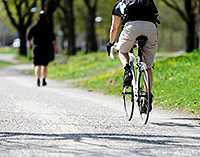Parks, Trails and Health

Parks and trails are an important part of a community. In a well-designed community, homes, parks, stores, and schools are connected by safe walking and biking routes. Such routes allow all members of the community a chance to enjoy the outdoors and get physical and mental health benefits.
Despite research showing the health benefits of physical activity, most U.S. adults and children are not active enough. CDC recommends that children and adolescents do 60 minutes (1 hour) or more of physical activity each day and adults do 150 minutes (2 and a half hours) of aerobic activity every week. In 2007, only about 35% of students in grades 9-12 met the recommended levels of physical activity, and in 2008 only 44% of adults met the recommended levels.
Having access to places for physical activity, such as parks and trails, encourages community residents to participate in physical activity and do so more often. The closer you live to a park, the more likely you are to walk or bike to those places, and use the park for exercise. However, only a small number of people in the U.S. live within half a mile of a park. People are also more likely to walk when they feel protected from traffic and safe from crime and hazards.
The physical activity you get from walking and biking to parks can have both environmental and personal health benefits. It decreases air pollution and car crashes which in turn can reduce chronic disease rates and traffic-related injuries. Physical activity can also help:
- control your weight
- reduce your risk of cardiovascular disease
- reduce your risk for type 2 diabetes
- reduce your risk for some cancers
- strengthen your bones and muscles
- improve your mental health and mood
- improve your ability to do daily activities and prevent falls, if you're an older adult
- increase your chances of living longer
Promoting Access to Parks and Trails
Some ways for communities to improve residents' access to parks and trails are to:
- build parks and trails within walking distance of homes, and help make sure that the routes to these places are safe,
- build and maintain sidewalks, crosswalks, bike racks, and bike paths at and on routes between parks and trails, and areas where people live, and
- control the speed of traffic on roads where people walk by how the roads are designed, setting low speed limits and enforcing traffic laws.
You can support and increase the positive impact of these improvements by:
- attending community planning meetings and advocating for parks and trails to be located close to residential areas, and
- choosing to live in homes closer to parks and trails when possible.
Resources
Parks, Trails and Health Tools
- Page last reviewed: October 27, 2014
- Page last updated: October 27, 2014
- Content source:


 ShareCompartir
ShareCompartir